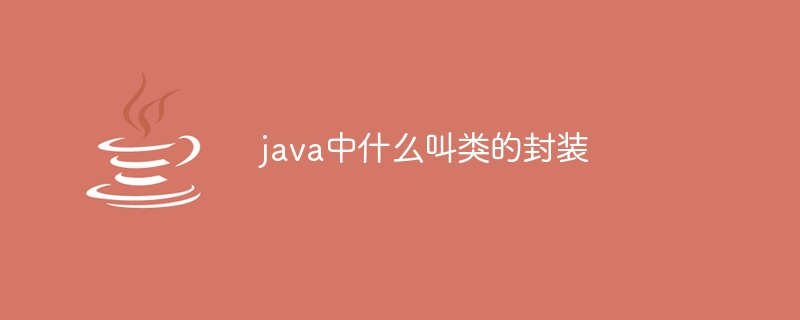What is class encapsulation in java
Class encapsulation limits access to class members in OOP, protects data integrity, and enhances code maintainability and security. Encapsulation is achieved in Java through access modifiers, such as private (only accessible within the class), protected (class and its subclasses), default (visible to the package), public (any class). Data members are usually made private and access is controlled through public methods to ensure that the data is protected.

What is class encapsulation?
Class encapsulation is a basic concept in object-oriented programming (OOP) that involves restricting access to the members (fields and methods) of a class. Through encapsulation, you can control access to these members, ensuring data integrity and security.
What is the purpose of encapsulation?
Encapsulation has the following benefits:
- Data hiding: Protect the data inside the class to prevent direct access and modification by external code.
- Data Integrity: By limiting access to critical data, you can help ensure data validity and consistency.
- Code maintainability: Make the code easier to maintain and understand by hiding the internal implementation of the class.
- Security: By controlling access to class members, you can prevent malicious code from manipulating or destroying objects.
Encapsulation in Java
In Java, encapsulation is achieved through access modifiers. There are four access modifiers:
- #private: Allows access only within the class.
- protected: Access allowed within this class and its subclasses.
- default (package visible): Allows access in all classes in this package.
- public: Allows access in any class.
Common practice is to make data members private to ensure they are protected. These members can then be accessed in a controlled manner through public methods. For example:
public class Person {
private String name;
private int age;
public String getName() {
return name;
}
public void setName(String name) {
this.name = name;
}
}In this example, the name and age fields are private and can only be accessed via getName() and setName() method access. This ensures that only these methods can modify the name value, thus maintaining data integrity.
The above is the detailed content of What is class encapsulation in java. For more information, please follow other related articles on the PHP Chinese website!

Hot AI Tools

Undresser.AI Undress
AI-powered app for creating realistic nude photos

AI Clothes Remover
Online AI tool for removing clothes from photos.

Undress AI Tool
Undress images for free

Clothoff.io
AI clothes remover

AI Hentai Generator
Generate AI Hentai for free.

Hot Article

Hot Tools

Notepad++7.3.1
Easy-to-use and free code editor

SublimeText3 Chinese version
Chinese version, very easy to use

Zend Studio 13.0.1
Powerful PHP integrated development environment

Dreamweaver CS6
Visual web development tools

SublimeText3 Mac version
God-level code editing software (SublimeText3)

Hot Topics
 1381
1381
 52
52
 How does Java's classloading mechanism work, including different classloaders and their delegation models?
Mar 17, 2025 pm 05:35 PM
How does Java's classloading mechanism work, including different classloaders and their delegation models?
Mar 17, 2025 pm 05:35 PM
Java's classloading involves loading, linking, and initializing classes using a hierarchical system with Bootstrap, Extension, and Application classloaders. The parent delegation model ensures core classes are loaded first, affecting custom class loa
 How do I implement multi-level caching in Java applications using libraries like Caffeine or Guava Cache?
Mar 17, 2025 pm 05:44 PM
How do I implement multi-level caching in Java applications using libraries like Caffeine or Guava Cache?
Mar 17, 2025 pm 05:44 PM
The article discusses implementing multi-level caching in Java using Caffeine and Guava Cache to enhance application performance. It covers setup, integration, and performance benefits, along with configuration and eviction policy management best pra
 How can I use JPA (Java Persistence API) for object-relational mapping with advanced features like caching and lazy loading?
Mar 17, 2025 pm 05:43 PM
How can I use JPA (Java Persistence API) for object-relational mapping with advanced features like caching and lazy loading?
Mar 17, 2025 pm 05:43 PM
The article discusses using JPA for object-relational mapping with advanced features like caching and lazy loading. It covers setup, entity mapping, and best practices for optimizing performance while highlighting potential pitfalls.[159 characters]
 How do I use Maven or Gradle for advanced Java project management, build automation, and dependency resolution?
Mar 17, 2025 pm 05:46 PM
How do I use Maven or Gradle for advanced Java project management, build automation, and dependency resolution?
Mar 17, 2025 pm 05:46 PM
The article discusses using Maven and Gradle for Java project management, build automation, and dependency resolution, comparing their approaches and optimization strategies.
 How do I create and use custom Java libraries (JAR files) with proper versioning and dependency management?
Mar 17, 2025 pm 05:45 PM
How do I create and use custom Java libraries (JAR files) with proper versioning and dependency management?
Mar 17, 2025 pm 05:45 PM
The article discusses creating and using custom Java libraries (JAR files) with proper versioning and dependency management, using tools like Maven and Gradle.




